It’s a dilemma that girls have faced for centuries. Dictated by society to be a princess or delicate flower, girls have faced a world that does not expect – or even want – them to be strong warriors. Yet history and pop culture hint that there are far more warrior women than we have been led to believe.
So we went on a search for the most butt-kicking, incredible girls we could find. We set ought to discover girls who have embodied what it means to be warriors, especially those who were royalty, in history, mythology, literature, and popular culture. We were hoping to find at least 30 women who embodied what it means to be a “warrior princess.”
We found over 200.
Now, join us to uncover the lives and legacies of these incredible girls. Welcome to Warrior Princess.
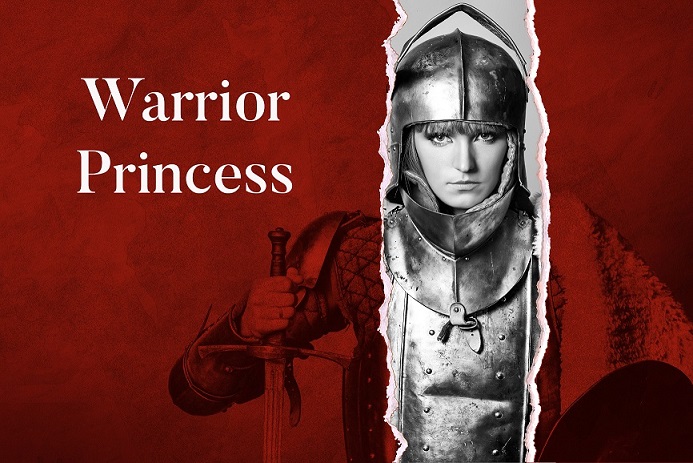
History
We began where all things do: history. In the tabs below, we explore the lives of young warrior princesses using fine art, photographs, books, and hints left in the historical record. These are just a handful of the hundreds of girls who held positions of power, led their people on amazing journeys, and embodied both the warrior and princess archetypes.
Queen Aah-Hotep (Aahotep I)
circa 1560 to 1530 BCE, Ancient Egypt
Aah-Hotep was born to be queen. The daughter of Pharaoh Senakhtenre Ahmose and his queen, Tetisheri, Aah-Hotep was destined to marry her brother, Seqenenre Tao, and become the Great Royal Wife of the Pharaoh. Yet fate had more planned than Aah-Hotep could have ever imagined.
Egypt was fragmented, with the Northern part controlled by the Hyksos. As Aah-Hotep took the throne, her husband waged war on the Hyksos in the hopes of reuniting Egypt. She ruled as regent – first for her husband, and after his death, for her 10-year-old son.
Aah-Hotep left few records of her life. What we do know comes from two artifacts. First, a stele in the temple of Amun-Re at Karnak was created by her son, Ahmose I, to honor her. It states,
“She is the one who has accomplished the rites and taken care of Egypt. She has looked after Egypt’s troops and she has guarded them. She has brought back the fugitives and collected together the deserters. She has pacified Upper Egypt and expelled her rebels.”
The other was found in her tomb at Dra Abu el-naga in Thebes: the “Golden Flies of Honor.” This necklace of three golden flies was an honorary award given for military service. She likely received it from her sons for her role in fighting the Hyksos while regent. A ceremonial dagger was also found, with an inscription bearing the name and epithets of her son, Ahmose I.
These gifts indicate that Aah-hotep did more than rule – she successfully led troops in battle, rescuing her people and casting out the Hyksos. Awarded honors normally accorded to men, she fought bravely in military strategy and overseeing her troops. Whether she ever fought in battle is a mystery, but this warrior princess went above and beyond her traditional role to ensure her son would rule Egypt.
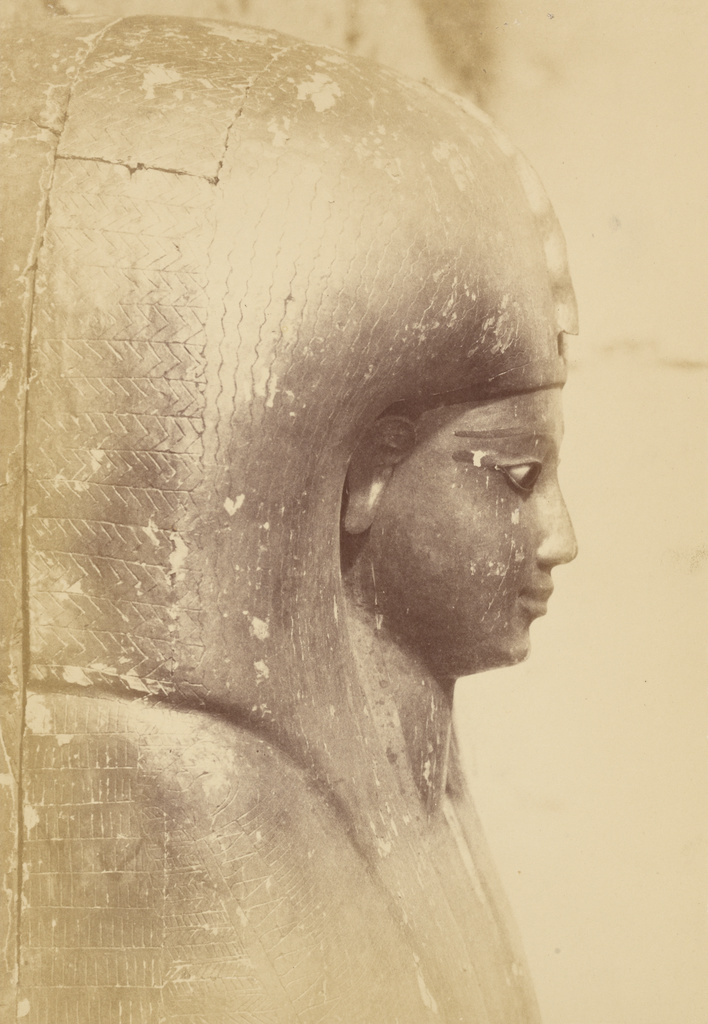
Close-up of the Sarcophagus of the Queen Aah-Hotep (Profile) (Source: Théodule Devéria (French, 1831 – 1871), 1859, Albumen silver print. 19.1 x 27.6 cm (7 1/2 x 10 7/8 in.). The J. Paul Getty Museum, Los Angeles.
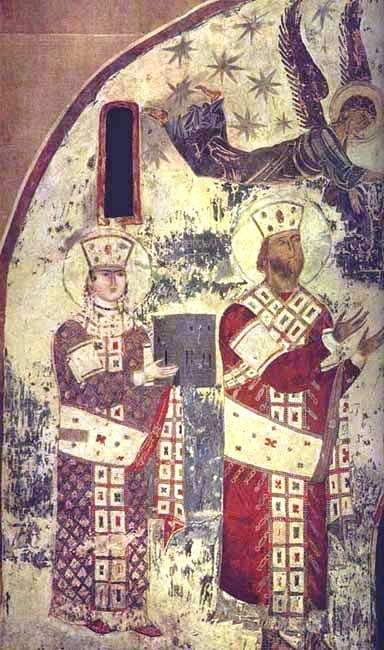
Mural from Vardzia depicting Tamar of Georgia with her father (Source: Wikimedia Commons.)
Tamar of Georgia
c. 1160 to January 18, 1213, Georgia
Tamar was the Queen of Georgia for nearly thirty years. Born to King George III and his consort, Burdukhan, we know nothing of her life until she was 18 years old – when her father made her co-ruler in order to prevent any disputes to the throne after his death. Only six years later, Tamar’s father died and she became Georgia’s first female ruler.
During the first years of her rule, Tamar faced enormous pressure from the aristocracy – forcing her to dismiss many appointees and even get married to a Rus prince! Her marriage was unhappy and led to a fracturing of the royal court. Fed up with the nobles bossing her around, Tamar stood up for herself and her country. Tamar began placing her supporters into the powerful clerical and secular roles, enabling her to take power away from the nobles and divorce her husband. From this point on, Tamar would rule her country – and her life – as she saw fit.
Tamar married an Alan prince, finding love and an ally who helped her defeat the nobles and expand her empire. In 1204, she proved her military prowess when she went to help her cousins punish the Byzantine emperor for confiscating funds for monasteries at Antioch and Mount Athos. Using the weaknesses of the Byzantine Empire and the defeat of European Crusaders during the Fourth Crusade, Tamar was able to seize the city of Trebizond and the province of Chaldia, positioning Georgia as the protector of Christians in the Middle East and supporter of churches and monasteries. Her campaigns established the foundation for the Empire of Trebizond, under her cousin Alexios’s rule, which flourished until the 15th century. She also struck a deal with the Ayyubid sultan Saladin that positioned Georgians as some of the most powerful Christians in the Middle East, able to travel to Jerusalem freely during a time when many Christians feared for their lives.
Tamar ruled as “King of Kings and Queen of Queens” for the rest of her life – consolidating power, expanding her empire, and ushering in the Georgian Golden Age. She became a dominant cultural figure, inspiring medieval poetry and speeches- including the poet Shota Rustaveli, who loved her so much that he confined himself to a monastery. Tamar lived a long life and eventually crowned her son as co-regent. In 1213, she suddenly became ill and was taken to the castle of Agarani, where she died. She was buried at the Gelati monastery, though her grave has never been found.
Today, Tamar remains a dominant cultural figure. She is celebrated as “protector of the widowed” and “the thrice blessed,” a warrior-queen whose efforts expanded and strengthened her empire while proving that a woman could rule as well – if not better – than any man.
Khutulun
c. 1260 to 1306 CE, Mongol
Khutulun was a renowned Mongol warrior, whose deeds and skills were praised from Europe to China. Born in 1206, she was the daughter of Qaidu Khan, a powerful ruler in Central Asia who opposed the rule of Kublai Khan and the establishment of a Mongol dynasty. Qaidu’s territory spanned from Mongolia to Oxus to India, and he was allied with several tribes against Kublai.
Khutulun was a beautiful girl, sought after by many suitors – none of whom she would have. She was more focused on her skills: riding horses, shooting arrows, and wrestling. Khutulun was so successful that she used wrestling as a means to avoid marriage, stating that she would only marry the man who could best her in the ring and would take a horse from each man who failed in his attempt. She amassed 10,000 horses by winning such matches.
Khutulun rode alongside her father in battle, helping him to keep Kublai’s armies from winning any of her tribe’s territory. As Marco Polo described, she would follow her father until a certain moment in battle, when she would “make a dash at the host of the enemy, and seize some man thereout, as deftly as a hawk pounces on a bird, and carry him to her father.” Her skills were so renowned that her father granted her a gergee – a large, heavy, engraved medallion worn around the neck that signified her power and independence. Khutulun was the only woman to ever receive one.
Eventually, rumors that Khutulun was having an incestuous relationship with her father spurred her to marry. She chose Abtakul of the Choros clan. But rather than settle down, Khutulun continued fighting in battle – both with her father and, eventually, her brother. She died in 1306 of unknown causes, and went down in the records of Marco Polo, Arab scholar Ibn Battuta, and the Ming Dynasty.
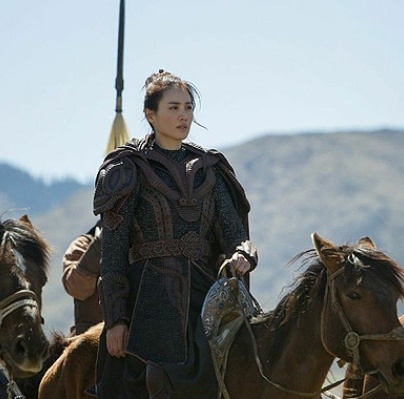
Khutulun, as played by Claudia Kim in the movie “Marco Polo.” (Source: Smart Bitches, Trashy Books)

Statue by Ben Ekanem commemorating Amina Sukhora in front of the National Arts Theatre, 1975 (destroyed 2005), (Source: Lagos State Government, via Wikimedia Commons).
Amina Sukhora
1400s or 1500s, Zaria (Nigeria)
Amina Sukhora was Queen of Zaria, a kingdom in the region of present-day Nigeria. Sources are conflicting on when Amina lived, and very little in the way of literature and artifacts exist to confirm her life. Instead, what we know has been passed to us through oral stories and the legends of her people.
Amina was the daughter of Bakwa Turunku, a ruler of Zaria towards the end of the 1400s. She was a fierce warrior, who loved fighting above all else. When Amina came of age, she refused to marry out of fear that she would lose her power and ability to fight. Instead, Amina helped her father turn Zaria into a trade center while conquering more territory through fierce battles. She was said to have taken a lover from among each group she conquered, spending only one night with the lover before having him castrated or killed.
After her father’s death, Amina ruled Zaria for nearly thirty years. She was the first ruler to establish a government among the tribes. Her skill in battle helped to conquer Nupe and Kwarafa, while enforcing tribute taxes and Zarian rule throughout the region. Amina also introduced kola, a type of nut, to her people as a harvested crop, and built many walls and schools to protect and educate her people.
Thought sources are few, Amina’s life was incredible. She rejected traditional notions of her place, favoring a life filled with her passions. She fought for her people’s bright future, both on the battlefield and in the many schools she built. And her life was so legendary that her people would keep her memory alive for hundreds of years in their stories and songs.
Running Eagle
Died c. 1878, Blackfeet
Born “Pitamakan” in Southern Alberta Canada, Running Eagle was part of the Blackfeet tribe. She was said to have preferred playing with boys as a child and, at the age of 12, began to wear boys’ clothing. Her father agreed to teach her the ways of boys, and she quickly became a skilled warrior.
During one hunting expedition, Pitamakan’s group was attacked by the Assiniboine (an enemy tribe). Her father’s horse was shot down, spurring Pitamakan to race into enemy fire and rescue her father. In celebration of her efforts, Pitamakan was allowed to sing the Victory Song and a Scalp Dance was performed in her honor.
Soon after, Pitamakan’s parents died and she decided to join a raiding party to bring back horses from an enemy tribe. During the raid, she captured eleven horses for her people, and kept the raiding party safe from enemy attack through her keen observation skills. Upon her return, tribal elders sent her on a vision quest to ascertain her destiny and put to rest any quarrels over whether Pitamakan should be allowed to be a warrior. Her visions were of the sun, who promised to give her great power in battle as long as she never slept with a man.
Pitamakan became part of a war party, participating in men’s ceremonies and taking the name “Running Eagle.” She went on to lead many successful war parties and hunting expeditions. Running Eagle never married, and died sometime around 1878 while fighting the Flathead warriors. Pitamakan Lake in Glacier National Park is named after her.
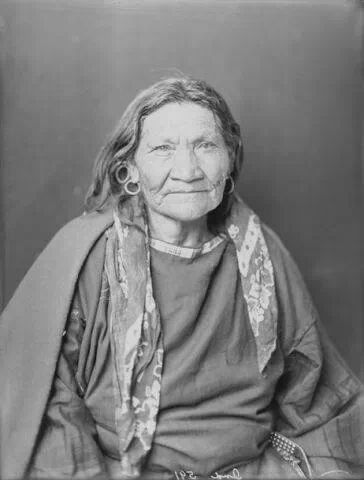
Running Eagle as an old woman. (Source: Indian Country Today Media)
Non-Royal Warrior Princesses
There are many historical girls who were both warriors and princesses. There are also girls who were not royalty, but their spirit and stories place them alongside royalty in status – and perhaps even beyond, into myths and legends. These historical girls are celebrated around the world.
In the video at right, the Smithsonian Channel tells the story of Nakano Takeko, a Japanese girl born to an Aizo official whose bravery during the Boshin War is celebrated every year at the Aizo Autumn Festival.
Folklore and Popular Culture
Warrior Princesses turn up in a range of stories, told throughout history and across the world. They are strong goddesses who play a role in the creation of the world, ferocious women who live forever as myths, and kick-ass characters in films, books and TV shows. In this section of Warrior Princess, we will be exploring some of the amazing warrior women of folklore and popular culture.
Hua Mulan
The main character in the Chinese poem, “The Ballad of Mulan”, written in the fifth or sixth century.
Hua Mulan is a legendary Chinese warrior, first written about in the Ballad of Mulan in fifth or sixth century China. While Mulan is being prepared, as every other Chinese girl at the time, for marriage and service as a wife, Mulan takes her elderly father’s place in the army when he is called to defend China from invaders. Mulan bravely says goodbye to her parents and joins the Chinese army, disguised as a man. She serves as a soldier for twelve years, becoming well known for her skill in martial arts and sword fighting.
At the end of twelve long years of fighting, the soldiers are able to return home. Those who have shown bravery are rewarded for their service, and Mulan is one of these to be rewarded but she refuses an official job with the army, requesting instead a fast horse to carry her home. After years of pretending to be a man in order to save her frail father, Mulan dresses in woman’s clothes, finally showing her fellow warriors who she really is. She returns home a hero.
Chinese society in the fifth and sixth centuries would have been a limiting place for a young girl with such aspirations. Women rarely left their households to do anything and wore heavy and cumbersome clothing. Influential women of the time were empresses, mothers of the emperor and famous beauties. In this ballad, Mulan’s disguise is based upon her choice of clothes, wearing men’s clothing instead of her own and cutting her hair in order to trick the Chinese army who wished to take away her father. In Chinese society and this time period, the value of daughters was described in terms of their respect and devotion to their father. While Mulan rejects expectations of women in terms of dress and job, this rebellion is expressed in a way that Chinese people of the time would respect. Her rejection of expected female roles is only done to save her father, and once the time of danger has passed, she returns to her place at her father’s side and once again takes up the role of daughter.
However, The Ballad of Mulan provided a strong female role model in a time and culture that offered women few opportunities. The fact that she was a woman did not affect her ability to develop skills of a warrior, suggesting that women and girls, given the opportunity, were indeed able to achieve the same skills and status as men. More recently, Mulan as a Disney character has represented Asian women in a time dominated by white, European or American characters and storylines, and a storyline that questions the pressures placed on young girls to be beautiful, graceful and obedient.
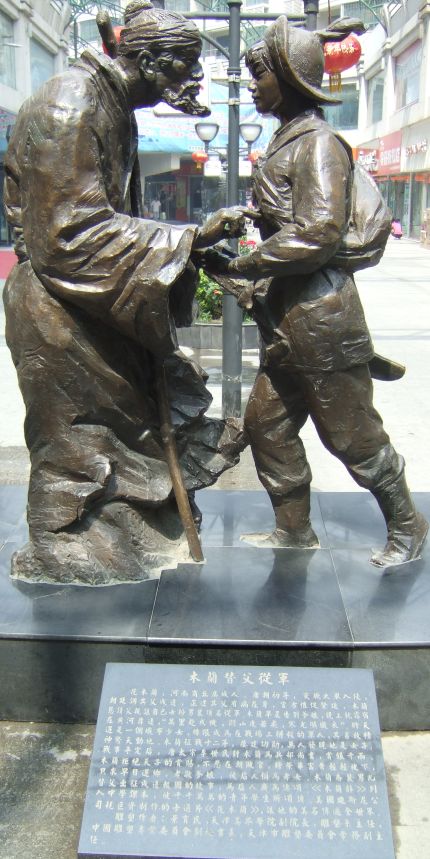
Iron statue of Mulan and her Father in Xinxiang, China. (Source: Wikimedia Commons).
The Changing Story of Hua Mulan: From devoted daughter to radical revolutionary
Mulan as depicted in the album Gathering Gems of Beauty (畫麗珠萃秀) (Source: Wikimedia Commons)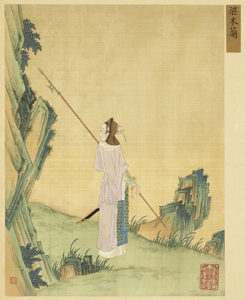
Celebrated as the most legendary and well-known Chinese woman warrior, Hua Mulan has been a constant source of inspiration for a wide variety of cultural forms, such as poetry, novels, plays, drama, film, television series and even video games. Although there exists no archeological evidence that points Mulan as a historically real person, her story was first written about in the Ballad of Mulan in fifth or sixth century China.
The ballad, albeit short in length, vividly describes Mulan as a young woman devoted to her family who, in order to defend her country from the invasion of a nomadic ethnic group, bravely takes her father’s place and disguises as a man to join the imperial troops. After bidding farewell to her parents, Mulan embarks on a series of remarkable military adventures and has fought for twelve years. Impressed by her years of extraordinary military service, the Khan, the emperor of Mulan’s time, offers her a prestigious official position in his court. But Mulan declines and requests to return back home to reunite with her family. Upon arriving home, she changes into her old clothes and the make-up expected of a woman of her status during this period. None of her military comrades could believe that there was a woman among them undetected for such a long period.

“Mulan” by an unknown artist, 1918. Held by the Kawamura Memorial DIC Museum of Art.
The two major themes that emerged from this original version of Mulan’s story—Mulan’s filial act of joining the army in her father’s stead, her daring transgression of gender norms through cross-dressing as a man, would resonate through numerous texts and renditions of her tale in later periods. However, in the Ballad of Mulan little narrative space has been devoted to the specifics of how Mulan disguised herself as a man. Mulan’s cross-dressing life that particularly interests today’s audiences has never been developed in the ballad of origin. In contrast, the ballad spends much time elaborating on Mulan’s relationship with her family. The Hua family is in a dire situation when receiving the Khan’s conscription demands: Mulan’s father is too frail to fight in the battlefield and her brother is still too young to join the army. Mulan is determined to take actions, but the ensuing separation with her family is filled with misery. She immediately feels homesick after leaving home, and her parents are worried about her safety and expecting a joyful family reunion. The ballad makes it clear that Mulan’s actions are motivated by her filial sacrifice for her father, not by her devotion to the central Chinese state and the Khan. Her relationship to the expected cultural norms was in fact one of obedience.
Today, Mulan is commonly understood as a patriotic female warrior whose filial sacrifice merges with her great service for the state. However, scholarly studies show that pre-twentieth-century tales of Mulan usually see Mulan’s sacrifice as an expression of devotion to her family rather than patriotic action, and view her as a figure of opposition and resistance to the central state. As Chinese nationalism started to gain currency from the start of the twentieth century, Mulan’s devotion was gradually subsumed into a statist discourse and her filial sacrifice began to be described as one of loyalty and devotion to the Chinese state.
Mulan’s story also started to take on a feminist tone at the turn of the twentieth century. Feminist writers frequently invoked Mulan’s image, rewrote or appropriated her life stories, and presented her as a radical revolutionary who did not only fight for national strengthening, but also for women’s liberation. In feminist writings Mulan appears as a shinning example of Chinese women warriors across history, and is compared favorably to heroic Western female warriors such as Joan of Arc. In these writings Mulan becomes the embodiment of such precious attributes as “courage”, “patriotism”, and “militarism” and Chinese women were mobilized to learn from her.
The sustained charm of Mulan’s story has transcended geographical boundaries and national borders in the contemporary world. While she remains to be the archetypal woman warrior in China, she also emerges as a heroine that enjoys worldwide popularity, a fascinating character in art and literature across different cultures, and a perpetuating symbol for bravery, courage, and honor. Perhaps whether Mulan is a real person or not actually matters not so much as long as she continues to encourage and inspire us.
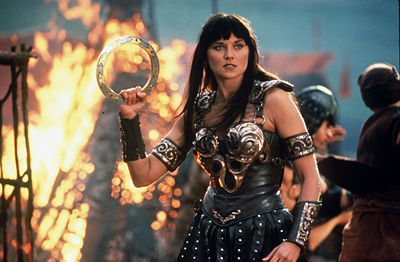
Xena, played by Lucy Lawless, in the episode “Return of Callisto.” (Source: Wikimedia Commons)
Xena
Ancient Greece
Xena is the main character from a television series, Xena: Warrior Princess. Born in the city of Amphipolis in Ancient Greece, Xena travels around Greece, using her fighting skills and strength to help people. In helping others, Xena is trying to make up for her violent past as a powerful and violent warlord. By fighting to save others, Xena fights for the ‘greater good’, rather to make herself mighty. While Xena is at times tempted to go back to her dark past, her best friend and ally Gabrielle helps her carry on. Xena’s preferred weapons are a chakram (a circular blade which is thrown through the air) and a sword.
During her time with Gabrielle, Xena takes on many of the gods and mythical creatures of Ancient Greece, and is shown to be more determined and brave than the legendary Amazons and great gods of war and destruction. In protecting the innocent and weak, Xena realizes that her strength can be used for good, rather than for selfish and evil ends. However, it is through her friendship with Gabrielle that Xena realizes her true calling as a protector, rather than as a selfish leader.
Xena represents a complex character, who is tempted to use her strength and skill in battle to become personally powerful, yet she realizes the damage that this can bring to others and to herself. While she is fiercely independent, only though a close friendship with Gabrielle does she realize her true nature. Xena is not the wife, or sister, or daughter of a warrior, but rather a woman who has independently developed skills to survive within a dangerous world, learning to use these for the greater good. While strong women did not historically engage in battle during the Ancient Greek period, Xena’s character takes on the mythological strength and fighting skills of the Amazons, and the independence of Greek goddesses such as Athena and Artemis.
In Xena: Warrior Princess, the male-dominated world of Ancient Greece has been imagined as a world where two women can be independent and fight (physically and emotionally) on the same level as men. The close relationship between Xena and Gabrielle has been seen by some as a romantic one, but in any case this storyline focuses on two strong women and the ways in which their different strengths are used to support one another. Xena’s defiance of expectations placed on women is demonstrated by her role as a warrior, but her style continues the idea that women should be attractive, even if they are fighting. However, her muscular and strong beauty provides a realistic character, much like Katniss Everdeen in the Hunger Games films – a body that is able to undertake the demands of an active and adventurous life of survival. Xena represents one of comparatively few strong female television characters that fight to be outside the expectations placed upon women, more than just a damsel to be rescued or a wife-to-be looking for true love. When Xena needs help, it is her friend Gabrielle that comes to the rescue.
“Girl Power” Revisited: Xena, The Warrior Princesses’ Heroic Legacy
Guest contribution by Dr. Anne Sweet, École Nationale des Ponts et Chaussées.

Xena Warrior Princess (and her nemesis Electra) action figures
Xena was part of a trend in the late 90’s of “warrior women”, strong powerful female action heroes in popular culture, like Lara Croft, Mulan, or Buffy, the Vampire Slayer. They were part of what was called “Girl Power”, promoting empowered images of young tough women heroes to female media consumers. These characters proved that “girls” could be as tough as the “boys”, yet the very use of the word “girl” was also a way to soften the message of female empowerment to make it socially acceptable and appealing to various audiences who might feel threatened by a woman who was too strong or independent. In a consumerist society fueled by the economic imperative to motivate girls and women to shop, TV executives created the women warriors featured in “Girl Power” cultural products to be role models of feminine beauty. Yet, as heroes, they also became symbols of what women (or girls) could achieve.
Of these, Xena, Warrior Princess, was surely one of the toughest and the most unique. Unlike other televised female (or male) heroes at the time, she was not wholly good. Her character began as a villainous warlord on Hercules the Legendary Journeys (1995-1999)—of which her series is a spinoff—but she later became good. She originally became violent because she was a victim: when her village was attacked, and her brother was killed. She went fully over to the dark side when her former flame, Caesar, betrayed her and ordered her crucifixion. As a warlord, she was quite cruel and ruthless. As a hero, she wished to redeem herself and was never free of her guilt for these past wrongdoings. She struggled with her dark side and worried about turning evil again.
Xena and Gabrielle costumes at WonderCon 2015 (image credit: Michael Li)
Her conscience, as it were, was her sidekick and “soulmate” Gabrielle, a bard, whom many fans also considered to be her love interest. Gabrielle was quite fully “good”, if still imperfectly human. Her blond, sunny, innocent appearance and personality contrasted with Xena’s dark character. Her morality was Xena’s guiding light. A romantic relationship between the pair was never openly acknowledged within the series, but many people viewed the two characters as lesbians. In the 90s, producers feared that advertisers and viewers would have a negative reaction to a fully gay character. So the audience were encouraged through subtle clues to read Gabrielle and Xena romantically—in the way they gazed at each other, or in they way they expressed how much they cared for each other. Dream sequences, magic or fantasy episodes, were also used by the producers to play with gender boundaries and allow the series to “flirt” with the audience and the idea of Xena and Gabrielle as a couple, by having them “be” someone else. In the episode, Return of the Valkyrie, for example, Gabrielle is enchanted and asleep inside a ring of fire (and thus plays the role of “Sleeping Beauty”) while the “true love” who must wake her is her “soulmate” Xena (who thus assumes the role of “Prince Charming”). The fact that Xena also had boyfriends meant that many fans actually read her as bisexual. Xena therefore became a very important and meaningful symbol to the gay community. For example, a group called “The Marching Xenas” dressed up as Xena and participated in gay pride parades.
Violence played a central role in the Xena series, but so too did female experience (image credit: Izzy Chan)
The representation of female heroism in the series was often groundbreaking, and frequently differed from the way male heroes were depicted. Xena was not just a male hero in a dress. She was also a mother, a friend, a daughter and a healer. Xena was skilled with a sword, tough and nimble. While she possessed great physical strength, it was often her cleverness that won the day. She even defeated an entire army by setting traps for them. Her violence and heroism were often “maternal “in nature, in that she strived to protect others who unable to fend for themselves, and worked for and with a community of friends and family, of both men and women. The series was notable in featuring a range of powerful women, including an Amazon tribe, the goddess Aphrodite (literally representing love as imperfect), and some rather formidable villainesses. Moreover, Gabrielle was not just a sidekick, she was often the hero, too, and saved both Xena and others on many occasions. Xena was also quite exceptional in terms of action heroes, both male and female, in that she was a parent. The sight of a pregnant warrior wielding a sword pushed at the boundaries of the idea of pregnancy as being incapacitating or limiting for women. Xena’s struggles to care for and protect her children mirrored the difficulties of work life/balance many real women face.
While the series could certainly be criticized for its violence—and the question could raised whether violent representations of any kind are good for society— it would be appear to be the very human aspects of Xena, rather than her prowess as a warrior, that many fans identify with and are inspired by, and that are her enduring legacy: her toughness and grit, her courage against the odds, the good she tried to do, her struggles not to be bad, and the love she shared with Gabrielle and others. Xena has even inspired a book called How Xena Changed Our Lives: True Stories By Fans for Fans and a charitable organization called “The Sword and the Staff.”
In the current day, the influence of Xena, Warrior Princess lives on. “Warrior princesses” are being featured in Once Upon a Time (2011-), for example, in which fairytale princesses are quite literally the heroes. The blond, “good”, Emma Swan (daughter of Snow White and Prince Charming) struggles to help the brunette Regina (the Evil Queen) stay good (and thus like Xena and Gabrielle before them, they have many “shippers”). Moreover, concrete plans are in the works to reboot Xena, Warrior Princess at NBC. Reflecting increasing acceptance of homosexuality and the fact that gay marriage is now legal in some countries, the new series’ executive producer has said he plans to bring Xena and Gabrielle back as an “out” couple. It should be interesting to see how this revamp of such an iconic character ultimately unfolds, especially as the NBC network is a mainstream platform. When the series’ first started, it was a low-budget series in syndication in the US (which means it was not broadcast in network primetime but acquired by various TV stations to fill “holes” in their timetables). It only reached its current and enduring commercial and cultural success through a groundswell of fan adoration.
Will this new version of Xena be as complex and inspirational to fans as her previous incarnation? Or will she be more of a weapon-wielding “princess” in boots?
Want to learn more about warrior princesses in religion, myth, and popular culture?
Check out our two special editions of GirlSpeak below:
The Warrior Girls of Never Ever After

Holly McKend currently lives in Birmingham (UK), but is originally from Scotland. She is one half of the team behind the webcomic Never Ever After, an award-winning comic having topped the Scottish Independent Comic Book awards in 2016. We had the great opportunity to interview Holly about Never Ever After and the work she does as a graphic artist.
How did you first get into comics?
I always liked reading the comics in the paper when I was small, but I really got into them when I was about 13 and my big cousin gave me some of his old comics, including Sandman and a collection of Calvin and Hobbes. I loved them and started doodling lots of characters, but I didn’t try to make a whole comic of my own until I got to university.
What was your first comic on?
My first comic that was more than a couple of pages for for a project at University and based around some characters that I’d made up at school. I’ve had a lot of stories and characters running through my head for as long as I can remember. It wasn’t my best work but it was a good learning experience!
How did you develop the skills necessary to create your own comic?
Mostly through practice and reading other peoples work. I studied digital art at university, but it was mostly focused on things like web design and animation, there wasn’t really a specific class that taught comics, but a lot of the animation work could be applied as it’s also visual storytelling.
How do you feel about female characters in comics, and has this influenced your own work?
This is a pretty difficult question to answer since female characters in comics are so varied. The big two (Marvel and DC) don’t have the best track record with their female characters, but I do think things are starting to change for the better with them, even if it’s a slow process.
I mostly read a lot of indie work, and there’s a huge, diverse community of female comic artists out there, creating wonderful work. There are comics on almost any subject if you look for them, so whatever your interests are, you could find something that you would enjoy.
Comic strip from Never Ever After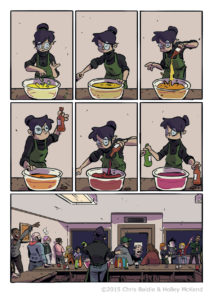
Never Ever After started about six years ago as a joint project with my then flatmate, Chris Baldie. We’d both tried to start a webcomic alone in the past and had given up a few pages in, so we decided to try to make one together so that we could bully each other into keeping at it. We’re still working on it now, so I guess it worked!
The story started out based around the characters Abel and Millie as they tried to navigate the strange things happening in their world. We made a few mistakes when we started out and have changed a lot as we rebooted the story. It has been a great learning experience and has since grown into a bigger cast of characters and better structured story.
Earlier this year we won Best Artist, Best Writer and Best Single Issue at the Scottish Independent Comic Book Alliance Awards for our first issue, so we have definitely come a long way from where we started.
What role does the character, Dot, play?
Dot started out as a side character, but she has since developed into one of the main cast. She’s one of the main forces that drives the story forwards. I can’t say too much right now without ruining the upcoming issues, but she’s the kind of person who doesn’t take any nonsense from anyone. She can come across as a little abrasive, but she’s got a heart of gold and she’ll do whatever she needs to to protect her friends.
What advice would you give to someone wants to be a graphic artist?
The main advice I would give anyone who wants to be a graphic artist is practice, practice, practice. Draw every day. Get yourself an account on Twitter and/or Tumblr and post your art for people to see. If you can, head down to conventions and talk to other artists. Create what you want to see, don’t try to create what you think other people want, make something that you feel needs to be put out into the world and share it.
Modern Warrior Princesses
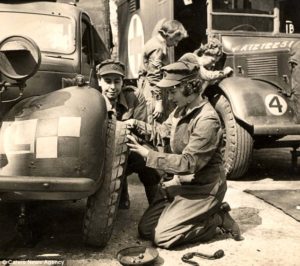
Queen Elizabeth during WWII. (Source: Wikimedia Commons)
The warrior princesses featured above are just a handful of the hundreds of stories, references, artworks, and artifacts we’ve uncovered. Their voices and legends are a testament to untold numbers of girls who – royalty or not – embodied what it means to be a warrior princess.
But in the modern world, can a warrior princess still exist?
We think they can. Whether royal or not, there are some amazing warrior princesses from recent history that inspire us…
For example, during World War II, Queen Elizabeth II contributed to the war effort in many ways. First, at her home at Windsor, she staged pantomimes with her sister to aid the Queen’s Wool Fund, which bought yarn to knit into military garments. At the age of 14, she made her first radio broadcast to address children who had been evacuated from Britain’s cities to ease their fears. And as she turned 18 years old, Elizabeth joined the Women’s Auxiliary Territorial Service as an honorary second subaltern, training as a driver and mechanic.
Today, the term “warrior princess” has evolved into its own archetype. Whether royal or not, these women are empowered and claim the “warrior princess” title in ways we’ve never seen before.

Parisa Tabriz (Source: Wikimedia Commons)
Parisa Tabriz is dedicated to protecting people through technology, and she has one of the best titles in engineering: “Google Security Princess.” Her job is to hack Google’s web browser in order to find flaws in the system and help protect the millions of people who use the browser in their everyday lives. The Iranian-Polish-American engineer gained the title after deciding “Information Security Engineer” was boring. As she stated in an interview with CNN,
“So I changed it to ‘Security Princess’ as more of a tongue-in-cheek thing. I’ve never been exceptionally girly or fit the stereotype of a princess, so it was a bit ironic for me to go by that name – and then it stuck!”
Another protector of the people is Kakenya Ntaiya, a Kenyan educator, feminist, and social activist who became a hero to girls in her country when she bargained for her right to attend school. She made a deal with her father: she would undergo the traditional Maasai rite of passage, female circumcision, if he would let her go to high school. Her story is one of courage and compassion, and has changed the destiny of hundreds of women in her country. Learn more in her TED Talk, featured below:
Bulgan Tsagaanzann, a female archer from Mongolia (Credit: Lila Seidman of Broadly)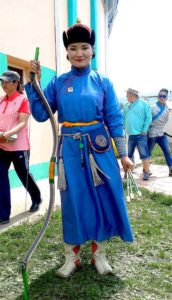
Cover of Kristen Beck’s book, depicting her as a soldier (Image: Wikimedia Commons)
Her memoir, Warrior Princess: A U.S. Navy SEAL’s Journey to Coming Out Transgender, proves that warrior princesses aren’t just amazing on the battlefield of war – but also on battlefields for social justice.
Together, these women represent the countless others who are true warrior princesses in our eyes. It is to them, and to all future warrior princesses, that we dedicate this exhibition.
What did you learn?
Download our Warrior Princess Educational Guide for fun activities related to the incredible girls featured in this exhibition. Designed for classroom or home use, this guide is aligned to US and UK educational standards.
Additional Resources
Want more warrior princesses? Check out these great books we recommend:
- Mulan: A Story in Chinese and English by Li Jian
- Goodnight Stories for Rebel Girls by Timbuktu Labs
- The Secret History of the Mongol Queens by Jack Weatherford
- Warrior Women: An Archaeologist’s Search for History’s Hidden Heroines by Jeannine Davis-Kimball
- The Woman Who Would Be King by Kara Cooney
- Warrior Princess: Fighting for Life with Courage and Hope by Princess Kasune Zulu
- African Princess: The Amazing Lives of Africa’s Royal Women by Joyce Hansen & Laurie McGaw
- Lady of Ch’iao Kuo: Warrior of the South, Southern China by Laurence Yep
- Fearless Girls, Wise Women & Beloved Sisters: Heroines in Folktales from Around the World by Kathleen Ragan
- The May Bird Trilogy by Jodi Lynn Anderson
- Changing Woman and Her Sisters: Stories of Goddesses from Around the World by Trina Schart Hyman
- Tale of Brynhildr (part of the Volsung Saga)
Credits
This exhibition was brought to life by:
- Devon Allen (curator),
- Tilly Aspbury (curator),
- Mary Horrell (podcast),
- Jessica Meagher (research),
- Sarah Raine (curator), and
- Tiffany Rhoades (curator).
We would like to thank all of our contributors for their contributions to this exhibition.
Special thanks to all the academics, researchers, artists and enthusiasts who continue the search to uncover warrior princesses throughout time. Your unwavering passion for giving them a voice inspires us, and helps us inspire the next generation of amazing warrior princesses.
